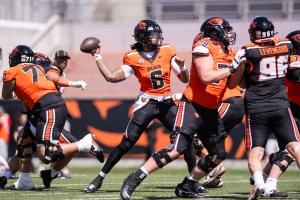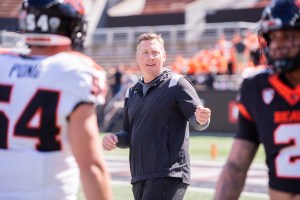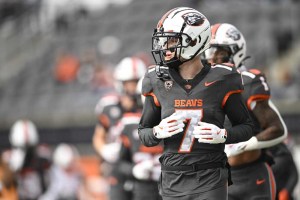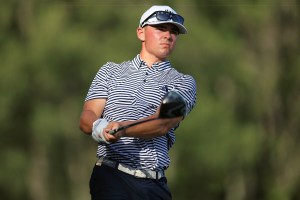‘More than just another football game’
Published 12:00 am Thursday, November 13, 2014
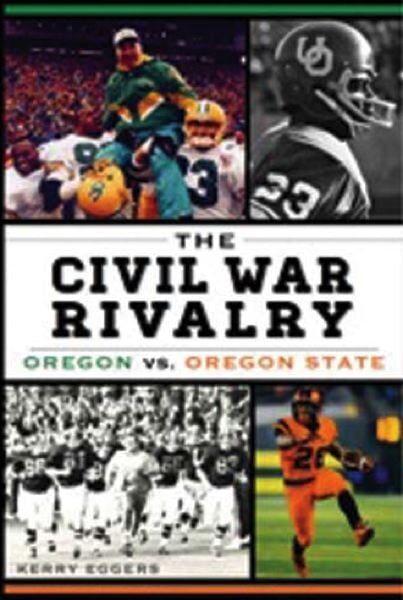
- Kerry Eggers' "The Civil War Rivalry."
Editor’s note: “The Civil War Rivalry … Oregon vs. Oregon State” is the newest book by Portland Tribune sports columnist Kerry Eggers. Here is an excerpt; see more from the book in future Tribune issues leading up to the 118th football meeting of the Ducks and Beavers on Nov. 29.)
Trending
The apex of Dee Andros’ 11 years at Oregon State came in his third and fourth seasons, 1967 and ’68. Some of the players were remnants of the Tommy Prothro era. More were Andros recruits who were big, strong, farm-boy types who fit perfectly into his “Power-T” offense and physical 6-2-3 defensive scheme.
Many of the stars on those two great Beaver teams were from small towns in the state of Oregon. Defensive tackles Jess Lewis and Craig Hanneman played together at Cascade High north of Salem.
“I came from a three-room, eight-grade Cloverdale Grade School near Turner,” Hanneman said. “Jess came from the big town of Aumsville. I’ll bet they had four rooms in their eight grades.”
Trending
Other key players included Jon Sandstrom from Sandy, Don Whitney from Pendleton, Larry Rich and Bill Plumeau from McMinnville, and Bill Enyart and Mark Dippel from Medford. There was also Scott Freeburn from Salem, Donny Summers from Grants Pass, Charlie Olds and Bob Jeremiah from Cottage Grove, Clyde Smith and Mike Nehl from Bend, and the Barton boys, Duane and Gary, from Baker. If you spread out a map of Oregon and pinpointed every rural section of the state, you’d be well represented on the Oregon State football squads of those years.
Andros recruited fullbacks and moved them to tackle or linebacker. Lewis and Hanneman were both fullbacks in high school. So was Sandstrom.
‘Great Pumpkin’ takes charge
In 1967, the starting interior defensive four were Lewis, Sandstrom, Ron Boley — who had been a quarterback at Parkrose — and 6-7 1/2, 260-pound Bill Nelson from Berkeley, Calif., who went on to play five seasons with the Los Angeles Rams.
The “Great Pumpkin” used an offense featuring a full-house backfield — a quarterback, two halfbacks and a fullback. Through his first seven seasons, the fullback was the focal point, with Pete Pifer, Bill Enyart, Roger Smith and Dave Schilling all taking on workhorse loads and having plenty of success.
The Beavers ran the option, and quarterbacks Paul Brothers, Steve Preece and Steve Endicott were all excellent runners — Preece the best of them — and savvy in orchestrating Andros’s patented option play.
“Dee’s offense was no-frills,” Enyart said. “It was a very basic system, but it was an effective system. We weren’t unexciting. We were a very exciting team. We had a great option quarterback, guys like Billy Main who could pick up big chunks and break it long, and we sprinkled in a few passes. I wish we’d have passed more. But it was basic and it was emotional. Dee was a fiery guy. With emotions, it goes two ways. Some games you win that you probably shouldn’t have. You probably lose some games you shouldn’t have because you didn’t prepare at a strategic level.”
Andros was always good with his motivational talks. He cranked it up a notch for the Civil War. “His speeches were better for the Ducks,” Enyart said. “He always said the game is for the right to live in the state for one year. It’s metaphorical, but in a sense, it’s true. If you live in the state, you’re either a Beaver or a Duck. After the game, you’re either gloating or you have your tail between your legs. He conveyed that to us. Nobody understood that more than me. When we played the Civil War game, it was more than just another football game. It was the most important thing in the world.”
Preece — his teammates called him “Fox” — was a fleet quarterback from Boise with limited passing skills but a perfect fit for Andros’ offense.
Recruited by every Pac-8 team except California and UCLA, he took advantage of the recruiting process. “In those years, you could sign a letter of intent with one school in each league,” Preece said. “I signed with Oregon State, Brigham Young, Utah, Colorado and Columbia. I visited Washington. On his visit to my home, (coach) Jim Owens took us out to dinner and ordered a glass of wine. My mom said, ‘You’re not going there.'”
• • •
Andros was an Oklahoma native. Enyart lived in Oklahoma before moving to Medford at age 11. The Enyarts loved Oklahoma coach Bud Wilkinson, who had coached Andros with the Sooners. Enyart’s father knew Dee and his brother from the Oklahoma days. There was a strong connection.
The 6-3 1/2, 235-pound Enyart played fullback and linebacker on the Rook squad in 1965. As a sophomore, he played weakside linebacker, moving into the starting lineup as a sophomore when starter Jim Godfrey was injured in the opener at Michigan. Enyart had a great season on the defensive side and had a big game in a 20-15 victory over Oregon. “My kids and I have watched film of that game quite a few times,” Enyart said. “I told them, ‘Guys, the older I get, the better I used to be.’ But I did have a pretty good game. I caused a fumble and made quite a few tackles.”
That spring, with Pifer having graduated, Enyart moved to offense permanently. “Dee had been a little resistant to me being a fullback,” Enyart said. “Dee and Ed Knecht, my freshman coach, wanted me to stay at linebacker. Dee and I had a meeting. I told him, ‘Coach, I want a shot at fullback. I love playing linebacker, but I came here to be a fullback.’ He gave me a shot, and I think it worked out pretty well.”
Enyart’s public nickname was “Earthquake,” the result of sports information director John Eggers liking the alliterative sound in promoting the Beaver fullback for All-America consideration. But Enyart’s teammates called him “Buffalo Bill,” which was shortened to “Buff.” He proved to be the right guy to play fullback in Andros’s offense. In the Power-T, an effective fullback was vital.
“We needed a blue-collar, durable fullback you could count on,” Enyart said. “Dee would roll over in his grave if he knew you were going to throw the ball on third-and-two. We made no secrets we were going to run the ball, and you’re not going to stop us. Our offensive line was fantastic, incredibly disciplined under coach (Sam) Boghosian. We had a great quarterback in Preece, too, and a lot of very good halfbacks.”
The halfbacks on the ’67 and ’68 teams — Billy Main, Donny Summers and Jerry Belcher — were excellent blockers. “We all had to block in our offense,” Main said. “Our split end, Roger Cantlon, was a great blocker. Our offensive line was terrific — guys like Lee Jamison, Dave Marlette, Rocky Rasley, John Didion, Clyde Smith and Roger Stalick. Those teams had a tremendous rapport between the backs and the linemen. We loved those guys and they loved us. As a team, we coalesced better than you could ever imagine. I’ve never been in an environment where there was more love or camaraderie.”
• • •
The best of the linemen was Didion, the 6-4, 255-pound center from Woodland, Calif., who initially committed to Brigham Young. “Their coach was Lavell Edwards, a great guy and a very successful coach,” said Didion, who died of a heart attack in December 2013. “Then (OSU assistant coach) Rich Brooks came to an all-star game I played in Sacramento and offered me a trip to Corvallis. I said, ‘Why not?’ And I fell in love with the school. It’s what a college campus is supposed to look like — ivy-covered brick buildings. Woodland is small. I didn’t want to go to an urban area. I got to talk to Coach Andros, and what a great communicator he was. I felt like I wanted to be part of what they were building.”
As a sophomore in 1966, Didion played behind 6-6, 270-pound Rockne Freitas, who went on to an 11-year NFL career. “Rocky was instrumental in my beginning weight training,” Didion said. “I weighed 190 as a freshman, and about 205 as a sophomore. Having to go one-on-one against him was like throwing a BB against a wall. That was one of the bigger keys to whatever success I had, getting bigger and stronger.”
Among the defensive stars was junior tackle Lewis, who had chosen Oregon State over Washington and Oregon. Lewis became one of the great two-sport athletes in Oregon State history, earning All-America recognition in football and winning a pair of NCAA heavyweight wrestling championships in 1968 and ’69. He finished sixth in the 1968 Olympic Games at Mexico City, earning a draw in his match with the gold medalist, Aleksandr Medved of Russia.
• • •
The 1967 Oregon State team began the season with impressive wins over Stanford, Arizona State and Iowa. The Beavers stumbled in Seattle, losing five fumbles in a 13-6 loss at Washington in which the Huskies scored the winning touchdown with two minutes to play. Hangover from that loss played a part in an ineffective performance the next week at home in a 31-13 loss to Brigham Young.
The next week, Oregon State paid a visit to Purdue, the nation’s No. 2-ranked team led by All-America halfback Leroy Keyes. The Beavers pulled off a stunning 22-14 upset. Two weeks later, OSU was facing another No. 2-ranked team on the road, UCLA. The result was a 16-16 tie that could have been another victory had not one of Mike Haggard’s extra-point attempts bounced off an upright.
After that game, talk turned to the Beavers’ next opponent — top-ranked Southern Cal and All-American O.J. Simpson. “We’re tired of playing No. 2,” Andros famously told reporters. “Bring on No. 1.”
Haggard’s second-quarter field goal held up in the Beavers’ 3-0 upset at Parker Stadium in what still remains on a short list of great performances in school history. Hence the term “Giant Killers” was born. Because of OSU’s loss to Washington and the tie with UCLA, the Trojans were headed to the Rose Bowl that season to face — ironically — Purdue. In those years, Pac-8 teams were prohibited from playing in any bowl games other than the Rose Bowl. So the Beavers, 6-2-1 and ranked eighth nationally, had only the Civil War game left to play.
Birth of the ‘Fighting Ducks’
In Eugene, the Jerry Frei era had begun. Len Casanova had retired and been replaced by his long-time assistant. Frei had played at Wisconsin, then moved to Oregon in 1949 to become an assistant coach at Portland’s Grant High. He served as head coach at Portland’s Lincoln High, was an assistant coach at Willamette, and then joined Casanova’s Oregon staff in 1955.
“Jerry was one of those type of people who was inspirational, and he had visions of Oregon becoming more than what we had been,” said Claxton Welch, a halfback from Portland’s David Douglas High. “He was the one who came up with the nickname ‘Fighting Ducks.’ He saw there was opportunity to become something special. We would come out of the locker room, jog over to our warm-up position in single file, break into four or five lines, and then you would start your exercises. It was something he picked up when he visited Notre Dame during spring practice. He wanted us to emulate the Fighting Irish.”
• • •
Oregon went into the 1967 Civil War game with a 2-8 record. The Ducks had played better in their last two games, a 17-13 win over Washington State and a 17-14 loss to Stanford, but the Beavers were nationally ranked and heavily favored when they invaded brand-new Autzen Stadium. Autzen opened that season with a capacity of 41,698, more than double that of old Hayward Field, which had become a hindrance to the program’s progress.
In 1965, the Ducks had played three of their five home games at Portland’s Multnomah Stadium. Former athletic director Leo Harris — then employed as a part-time consultant by the athletic department — considered the new facility a first step toward joining the big time in college athletics.
“From a cold, analytical standpoint, football is the only successful method to finance the entire athletic program, and our objective is to build a first-class program,” Harris told the Duck Club the week before the Civil War.
“Our facilities at Oregon — I think they are the best in the PAC — will make a tremendous contribution to our athletic program. But we must build with football as the foundation. We must field a representative team every year, not every other year or every three years. Money has never been the problem in the football program. We’ve always had plenty of money. Until this year, the Oregon athletic department has never used all its aid money. We’ve never had enough football players to warrant using it all. The difficulty has been in the area of recruiting. … Football hasn’t seemed important. … There has been a general apathy toward football. Until you solve this, it won’t make any difference whether or not you have the money to get players. Football is important at Oregon, just as all school-related activities are important. I hope you as alumni demand this. You have been too complacent in the past, but you have the ability, and I’m sure the desire, to change this.”
• • •
A Civil War record crowd of 40,100 — paying $6 for reserved seats, $3 for general admission and $1 for students — watched the two-touchdown underdog Ducks nearly pull off an upset in 1967. Oregon led 10-0 going into the fourth quarter before Oregon State pulled out a 14-10 victory. Earlier in the day, USC had beaten UCLA, clinching a Rose Bowl berth.
Perhaps there was some hangover on the Beavers’ part from the emotional victory over Southern Cal the week before. Perhaps there was disappointment that there would be no bowl game. Perhaps they overlooked the Ducks.
“We found out during warm-ups we were out of the Rose Bowl picture,” Preece said. “I really feel we’d have been capable of beating the Ducks by 30 if the Rose Bowl had been on the line, but we played pretty miserably.”
• • •
Junior Enyart, whose fourth-quarter work was the key to Oregon State’s comeback that day, felt it was his coming of age as a Beaver fullback.
“We were coming off the SC win, and had a little bit of an emotional letdown, and the Trojans can physically take a lot out of you, too,” said Enyart, who carried 35 times for 167 yards. “But I was feeling good. That day was when I came into my own as a fullback.
“Bud Wilkinson always said if you make 3.4 yards a carry, you’ll never get stopped. I averaged about five yards a carry. With that in mind, if they gave the ball to me, we were theoretically never going to get stopped. That was Dee’s philosophy. I knew I wasn’t going to break long runs, so I was content to get a lot of good short runs and make the (defenders) pay a price to tackle me and set up the option for the bigger runs.”
• • •
The 1968 season was a “could-have-been” campaign for Oregon State. The Beavers were ranked No. 2 nationally in Playboy magazine’s preseason spread.
They wound up losing three games by a total of six points in a 7-3 season.
They dropped two of their first four contests by a point apiece — 21-20 at Iowa in the opener, then 35-34 in the fourth game at Kentucky. The only other loss came in the penultimate game, a 17-13 defeat at Southern Cal.
Oregon State and USC both went into the game 4-0 in PAC play, so in essence, the Rose Bowl was on the line. The
Trojans, led by Heisman Trophy winner Simpson, were 8-0 overall and again ranked No. 1 nationally.
With Simpson carrying 47 times for 238 yards, the Trojans scored 17 fourth-quarter points to win.
The lack of a place-kicker had been OSU’s Achilles heel all season. Highly regarded sophomore Pat Arnold had been in a preseason automobile accident and wasn’t able to perform. Larry Rich was called on to kick extra points, and tackle Kent Scott handled field goals. Rich had missed extra points in the losses at Iowa and Kentucky, the latter after OSU’s final touchdown and the Beavers behind 35-34. Against USC, Scott missed field-goal attempts of 21, 30 and 32 yards in the first half.
“Had Mike Haggard been back, we’d have been national champions that year,” Enyart said.
• • •
Oregon had made strides in Frei’s second season. The Ducks went into the 1968 Civil War 4-5 with a chance to finish the year at .500. Before the game, Frei called Oregon State, ranked 16th nationally, “the finest college offensive football team I’ve ever seen.” But, said Frei, “I’ll tell Dee or anyone else we won’t play this Saturday as we did against Cal (a 36-8 loss), and we’re not going to Corvallis to concede.”
The Beavers, though, were ready. “That game was the crown for the Giant Killers group,” Enyart said. “We had struggled against the Ducks the year before. They’d put up a great effort against us. The seniors knew this was the last time we were putting on an Oregon State uniform. It was an emotionally charged time. We always stayed together at an Albany motel the night before a home game. We’d have cookies and cocoa together about 10 o’clock. Donny Summers read a poem to everybody that he had put together that day. I didn’t know Donny had it in him. I swear we had tears in our eyes listening to him.”
The Ducks were no match for the Beavers in a 41-19 loss at Parker Stadium.
Oregon was poised to take out Preece on Oregon State’s patented option play. Preece had broken a shoulder the previous season, and opponents that year often took shots at it. Early in the game, UO defensive end Dennis Gassner cold-cocked him. Main saw it.
“Billy told me, ‘Run that play again,'” Preece recalled. “I ran it again, and Main goes flying by me and hits (Gassner) so hard I thought he was going to kill him. He’s standing over him, screaming, ‘Don’t touch my quarterback again.'”
Enyart rushed 37 times for 168 yards and three touchdowns.
“We were a really good team — arguably better than the Giant Killers of the year before,” said defensive tackle Hanneman, a sophomore that season.
“When we were clicking,” Main said, “we were the No. 1 team in the nation in both ’67 and ’68.”
“That was a hell of an Oregon State team,” Oregon tight end Andy Maurer said. “They should have beaten us a million to nothing.”


